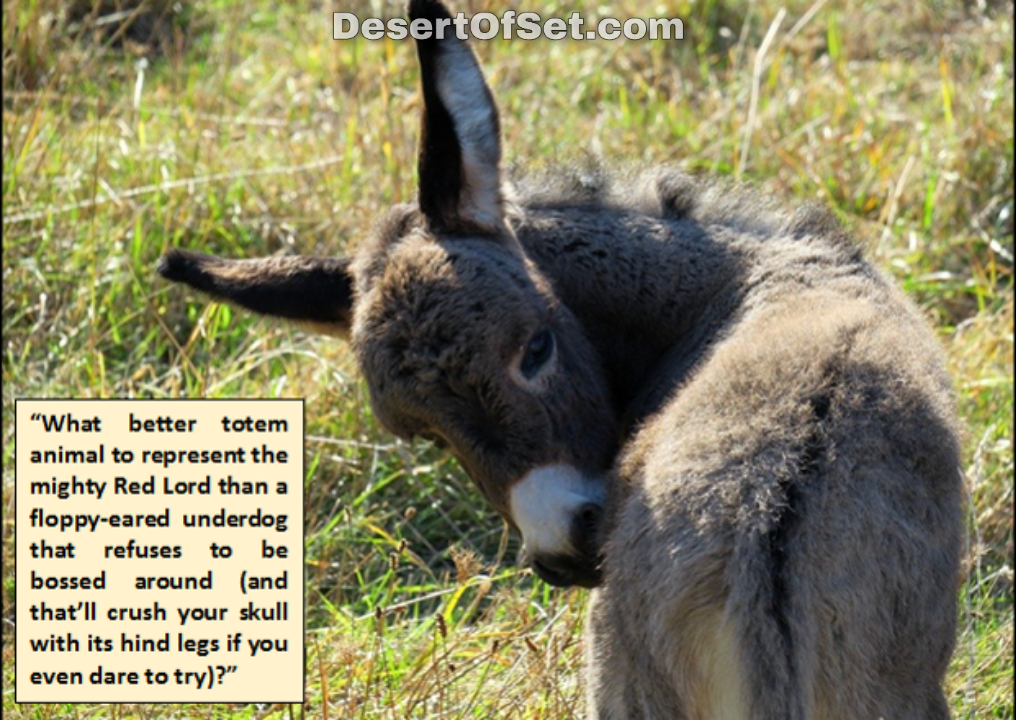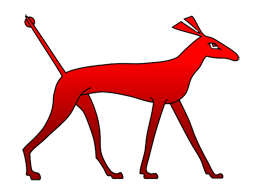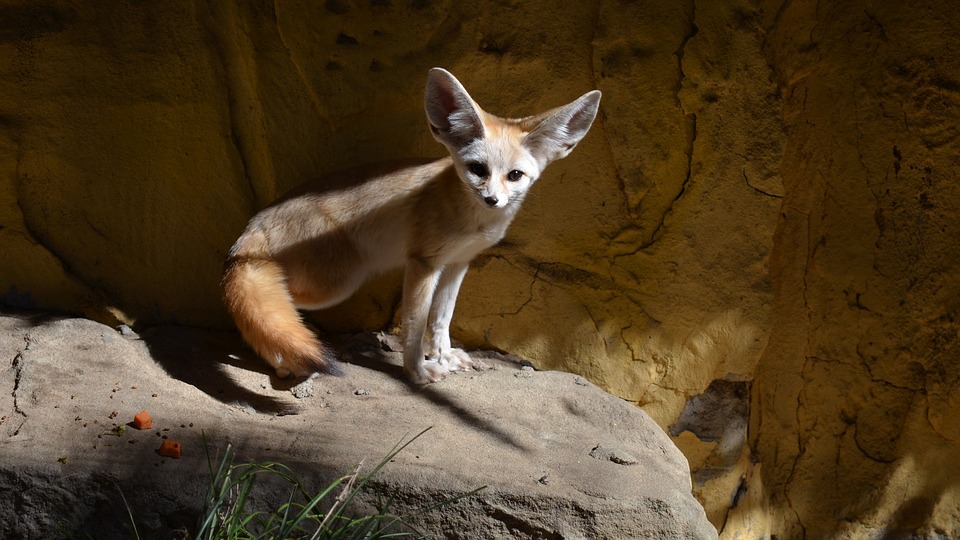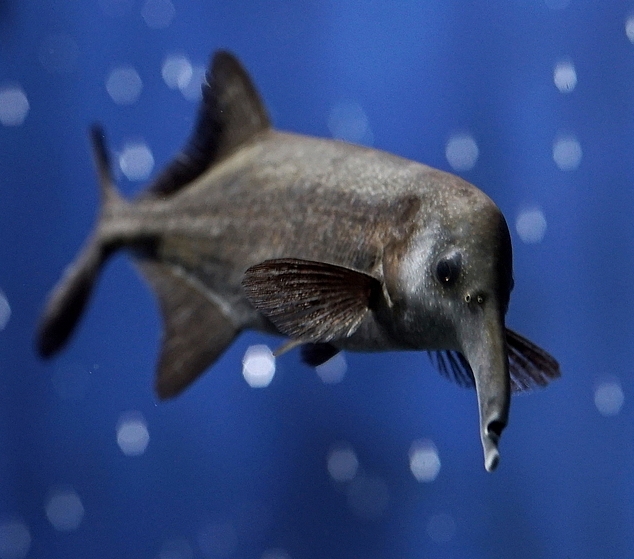A discussion of the animals that are sacred to Set—including donkeys, pigs, hippos, oryx, and elephantfish.

As with most other Egyptian gods, certain animals are considered sacred to Set. First and foremost is the mysterious creature that the Egyptians called the Sha.

The Sha Animal
This little fella—which is otherwise known as the “Set Animal” or “Typhonian Beast”—is one of history’s greatest cryptids. It resembles a red-haired greyhound with rabbit ears, a long curved snout, and a forked tail. Egyptologists are divided as to whether this animal actually existed and went extinct, or if it’s just a mythical creature the Egyptians created from bits and pieces of different animals (like a dragon, griffin, or phoenix). Some authors have theorized that it may be a stylized hyena, jackal, aardvark, or fox. It might actually be a fennec fox, which looks like this in real life:

The Fennec Fox (From Pixabay.com)
Fennec foxes are nocturnal, and they’re native to the Sahara Desert in Northern Africa. As you can see, this little guy has the biggest ears you’ll ever find on any member of the Canidae family, and he even has reddish-orange hair. Fennec foxes are also very social animals, they mate for life, and they can live for up to 14 years in captivity. Unfortunately, they are often hunted by indigenous African tribes. They don’t cause any direct harm to humans (like attacking people or livestock), but their fur is highly prized. It hasn’t been definitively proven that the Sha is really a fennec fox by any means, but considering the shape of the Sha’s body in Egyptian religious art, I think this is the most likely possibility.
Later on, in Greco-Roman times, Set was more often drawn as a donkey-headed man, and donkeys are probably my favorite Setian beasties. Conventional wisdom assumes that a donkey’s stubbornness is due to stupidity (which is why the word “jackass” later became a derogatory term for people who act like imbeciles), but it’s actually because they’re very wise and cautious. It’s extremely difficult to force or frighten them into doing anything they perceive to be dangerous, and you must earn a donkey’s trust before you can convince it to work with you. Donkeys are so resistant to being bullied, in fact, that farmers will often keep them stabled with horses to keep the horses from spooking so easily. Other animals just seem to feel better when there’s a donkey around, which makes perfect sense to me. What better totem animal to represent the mighty Red Lord than a floppy-eared underdog that refuses to be bossed around (and that’ll crush your skull with its hind legs if you even dare to try)? Not to mention that donkeys are really very trusty companions and workers once you get to know them (and once they get to know you).

The Donkey (From Pixabay.com)
Pigs are also sacred to Set, and this includes all pigs (from Miss Piggy to those big Razorbacks that gore people to death in the Australian Outback with their tusks). Big Red takes the form of a black boar when He blinds one of Horus’ eyes in Egyptian mythology, which is just one reason why pigs are so often considered “unclean” in some faiths today. Other reasons relate to religious dietary laws and the fact that pigs are genetically closer to humans than any other animal. In Judaism and Islam, animals must have split hooves and chew their cud to be considered kosher or halal, and while pigs have split hooves, they don’t chew their cud. At the same time, pig flesh bears the closest resemblance to human flesh (i.e., “the long pork”) in the entire animal kingdom, as evidenced by the fact that pig carcasses are so often used by crime scene investigation units when they re-create crime scenes. In light of this resemblance, some ancient cultures probably thought that eating pork was much too close to cannibalism for comfort.

The Pig (From Pixabay.com)
Some Egyptologists have theorized that the Sha isn’t really a canid at all, but some kind of feral hog. (P. E. Newberry once claimed that some feral hogs have greyhound-shaped bodies, but I have yet to see anything like this for myself.) I’m skeptical of this interpretation, but I do think the Sha’s tail and curved snout are similar to those of a wild boar. In any case, perhaps the connection between Set and pigs is what inspired the creators of the Legend of Zelda video games to give the evil sorcerer Ganon a boar’s head.
In one myth, Set takes the form of a hippopotamus while battling Horus. Hippos are semi-aquatic, spending most of their time in water and only walking on land at dusk. They’re also the toughest and most dangerous herbivores on Earth. Male hippos are especially aggressive and were highly feared by the Egyptians for their tendency to attack people without provocation. They were revered by Zulu warriors for this same quality, and were considered braver and more difficult to kill than lions.

The Hippopotamus (From Pixabay.com)
If you’ve ever seen a baby hippo, you’ll know it’s just about the cutest thing in the entire world…and you’ll wonder how such a cute little thing could possibly grow up to become one of the world’s deadliest creatures. One of my least favorite things about ancient Egypt is that the Temple of Horus at Edfu includes an engraving of Horus spearing a baby hippopotamus. The image represents Horus defeating Set in one of their many battles, so I know it shouldn’t be taken literally. But I can’t help but wonder if it doesn’t also represent an actual ritual in which a priest of Horus might have slaughtered a captured baby hippopotamus as a way of sticking it to Big Red (which would be shitty).
Then there’s the oryx, which is a type of African antelope. Big Red was sometimes called “the White Oryx” and was also identified with antelope in general (perhaps as a result of being worshiped by desert-dwelling hunter-gatherer societies). The funny thing is, oryx, pigs, and hippopotamuses are all members of the same order, Artiodactyla, which includes all of the even-toed or “cloven-hoofed” ungulates (e.g., goats, sheep, deer, giraffe, etc.). It is no accident that cloven hooves were later identified with the Christian devil, who was identified with both Set and the oryx by the Coptic Church. It’s bizarre to me that horned, cloven-hoofed critters like the oryx and the goat would come to be considered “satanic” by such people, since they’re herbivores that pose absolutely no threat to human beings.

The Oryx (From Pixabay.com)
Finally, Set is said to be rather fond of fish. When He drowns and dismembers Osiris in Egyptian mythology, He feeds the god’s phallus to a fish. No one’s really sure what kind of fish this supposedly was, but some sources theorize that it’s a member of the Mormyridae or “elephantfish” family. They’re called “elephantfish” because their snouts resemble elephant trunks. In fact, you might say that the faces of these fish bear a striking resemblance to the sha animal:

The Elephantfish (From Wikimedia Commons)
I think it’s pretty safe to assume that Set’s fish is from the Mormyridae family, for the Egyptians were nice enough to make statues of the fish, especially in a city called Per Medjed or Oxyrhynchus (a Greek name which means “Town of the Sharp-Snouted Fish”). For whatever reason, the fish that swallowed Osiris’ penis was especially beloved to the people of this city. This is especially interesting since Oxyrhynchus was located in what archaeologists call “Upper Egypt” (i.e., the southern and most desert-like half of the country, which was dedicated to the cult of Set in predynastic times). Their statues of Set’s fish show once and for all that the fish is definitely a Mormyrus of one kind or another.
It’s ironic that a barren desert god would be associated with an aquatic animal, but it makes perfect sense to me at least. If you’re accustomed to living in an arid desert wilderness, what would you expect heaven to be like? You’d probably imagine it to be a place where there’s never any shortage of water, like an oasis, a lake, or even an ocean. The fish, in turn, would be seen as a powerful symbol of hope. Interestingly, Oxyrhynchus was one of the first Egyptian cities to accept Christianity under the Coptic Church. (Numerous non-canonical Christian texts have been discovered there.) Early Christians used the Ichthys or “Jesus Fish” as their primary religious symbol long before they switched to using the crucifix, and perhaps this is something that attracted the people of Oxyrhynchus to Christianity.